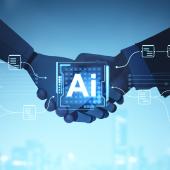Banner artwork produced by Shutterstock.AI
AI is transforming how business and legal teams work. In-house lawyers, outside counsel, and other professionals highlighted key trends during the ACC webcast “The AI Legal Revolution: How Generative Artificial Intelligence Will Transform the Role of In-house Counsel and External Law Firms over the Next Five Years.”
Below are 10 key takeaways to better understand the AI landscape for in-house lawyers. Also, learn more tips and strategies for helping the business navigate AI in the newly published Artificial Intelligence Toolkit for In-house Lawyers, available in the ACC Resource Library.
- Legal teams use AI to help them provide advice, manage transactions, and improve compliance.
- Use cases include leveraging AI to automate tasks and workflows, summarize email threads, take notes, create presentations, draft communications, assist with contract review and analysis, identify patterns (such as compliance issues and discerning risks before they materialize), and enable faster decision-making.
- AI capabilities are increasing and leaning toward “deep reasoning” — such as to analyze legal arguments and predict rulings, or to perform contract risk analysis and articulate a rationale for the risk assessment.
- Proper data governance is key to using AI successfully. For effective use of AI tools, you need clean, curated datasets, which requires robust data governance.
- Get in, don’t stay outside the room. Take part in technology teams’ discussions on developing AI tools or products that involve AI.
- Lawyers are wary of the risks of using AI in their work. Lawyers increasingly use AI and are optimistic about the benefits of doing so. However, many are still concerned that risks — hallucinations, disclosure, etc. — outweigh productivity benefits. Check out the ACC research findings on The Impact of AI on Attorney-Client Privilege.
- Training people is essential. AI adoption requires a cultural adaptation. Don’t assume your workforce uses AI properly and effectively. Educate them regarding proper use, train them on specific use cases, and encourage sharing best practices within your organization (e.g., effective prompting).
- Keep in mind limitations on copyright protection of AI-generated output. Human authorship of the content is still largely a requirement for IP protection.
- Clients increasingly expect law firms to use AI tools to gain in efficiency and reduce the cost of labor-intensive tasks. This may impact billing structures. Many law firms have hired AI technical professionals. Consider asking your law firms how they are using AI, and to help educate you on how your department can use AI.
- Trust, but verify. Don’t rely blindly on AI. Keep in mind your professional duties (competence, etc.). Even if AI tools are getting more sophisticated, they are still prone to inaccuracies, fabrications (“hallucinations”), and bias. Ultimately, you are responsible for your use of the tool (and its output) in providing legal services.
In-house lawyers must keep up and harness fast-developing AI capabilities to serve and guide their organizations effectively.
Don’t miss ACC’s AI Toolkit for In-house Lawyers:
- Scan the landscape: Key ACC survey findings on in-house and AI.
- Anticipate: An outlook on 10 AI trends in 2025.
- Increase your skills: Nine checklists to help you succeed in your AI journey.
- Save time: A selection of tools and resources to support your in-house success with AI.
Disclaimer: The information in any resource in this website should not be construed as legal advice or as a legal opinion on specific facts, and should not be considered representing the views of its authors, its sponsors, and/or ACC. These resources are not intended as a definitive statement on the subject addressed. Rather, they are intended to serve as a tool providing practical guidance and references for the busy in-house practitioner and other readers.




